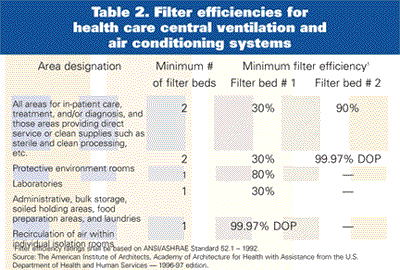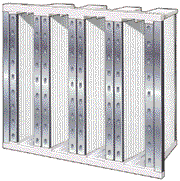
When the hvac staff completed training based on the National Air Filtration Association (NAFA) Installation, Operation and Maintenance (IOM) of Air Filtration Systems manual, several questions were raised by the technicians regarding the original filters installed in the East Wing.
The chief engineer, Peter DeBlois, and lead hvac technician, John Tebo, were looking to implement the latest technology in air filtration for the new wing of the facility.
The reasons for considering changes in the air filtration system were to conserve energy regarding operational costs of their system.


Original System Design
The air-conveyance system is a variable air volume (vav) type, with a modular, bank frame filtration system with upstream service.It has two air-handling units (AHU), with 65 24- by 24-in. filters for each unit.
Both AHUs were designed to deliver approximately 80,000 cfm. The original prefilters supplied with the system were 25%3, 4-in., extended-surface pleated filters upstream of the coil section. The final filters were 90%3 12-in.-deep, conventional rigid box-type filters with approximately 50 sq ft of micro-fine fiber glass media (see Figure 1).
The manufacturer’s published initial resistance of the final filters is 0.82 in. wg operating at 500 fpm, with the maximum recommended final resistance of 1.5 in. wg.
The prefilters were scheduled to be changed out every six months and the final filters, every 12 months. The pressure differential devices originally installed were dial and pointer-type gauges.

Low Cost, High Performance?
The cost to underrate and upgrade the health care center’s filtration system was a minimal, initial cost only as the products selected required no system modifications.The prefilters chosen for AHU #2 were 30%3, 4-in.-deep, high-capacity pleated filters. The final filters were the 95% V-Cell, 12-in.-deep, high-capacity, mini-pleat type.
The airflow resistance published by the manufacturer is 0.36 in. wg at 500 fpm. Installation of the filters included a system shutdown with proper lockout, tagout procedures, and lights in both units were shut off.
DeBlois used a flashlight to examine the filter holding frames upstream of the final filter bank. Tebo checked the downstream side to caulk and seal any air leaks.
To gauge the effectiveness of the new filters, AHU #1 continued to use the same type of filters provided with the new installation.
The pressure differential gauges were zeroed and the static pressure tips were inspected to ensure proper location in a zone of minimum turbulence.
The final filters for AHU #2 using the V-Cell, mini-pleated filters are now scheduled for a biannual changeout. Filters will be changed out every 24 months, vs. every 12 months for the conventional, rigid box-type filters in AHU #1.

The Results
The overall cost savings achieved were significant.The V-Cell filters have approximately 200 sq ft of media vs. 50 sq ft on the rigid box filters. Underrating the system and implementing the high-efficiency, high-capacity V-Cell final filters lowered the pressure drop and improved airflow rates.
Actual airflow monitoring data of both units are shown in Table 3. It displays the performance differences.
The benefits of the program established by the Engineering and Maintenance Department at the medical facility can be a model for other organizations looking to improve overall efficiency and performance of hvac filtration systems by implementing these changes.
Underrating and upgrading filtration systems can be realized with proper training by a NAFA Certified Air Filter Specialist (CAFS). Facility owners can save on energy costs while maintaining a safe, clean, comfortable indoor air environment for occupants.
Stephen W. Nicholas, CAFS, is the president of Air Industries, Inc., an independent manufacturer’s representative of hvacr equipment and supplies. He is a member of ASHRAE, AEE, ACCA, and is a CAFS by NAFA. Nicholas is also a member of NAFA’s Technical Committee.

Report Abusive Comment